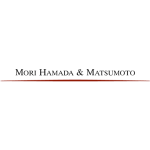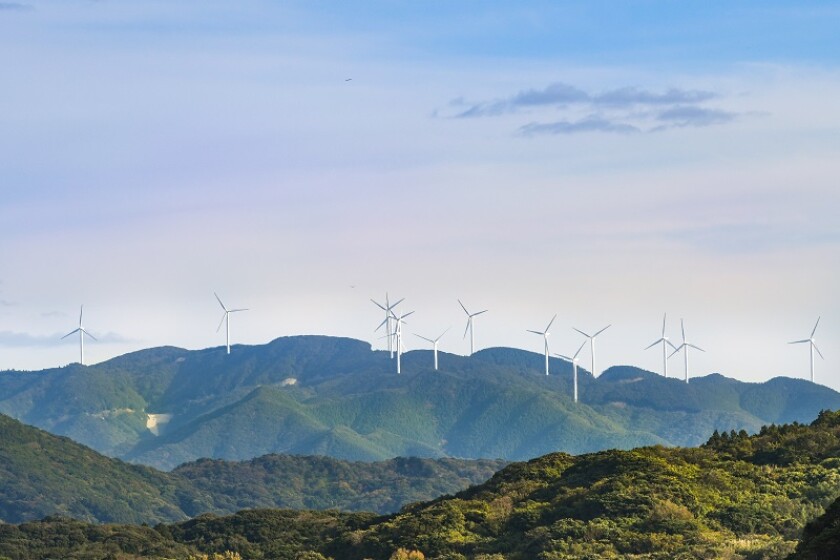Yusuke Murakami and Hironobu Noma of Mori Hamada & Matsumoto outline opportunities and strategies for success in Japan’s emerging offshore wind market
Since the Japanese government introduced the feed-in-tariff (FIT) programme in 2012, the renewable energy industry has been rapidly growing. The projected energy mix published by the Japanese government in 2017 sets the target for renewable energy at 22-24% of the total energy supply as of FY 2030. Also, the fifth strategic energy plan unveiled in 2018 clearly sets out the national policy to develop renewable energy as the main source of power. Offshore wind, in particular, has attracted considerable attention from both developers and financiers.
Historically, offshore wind technology first grew in Europe in the 1990s. Consistent political support was the key driving force for the stable growth of the industry. Also, constant technological innovations have enabled the development of larger wind farms with significantly lower cost. On the other hand, Japan has huge growth potential for offshore wind as, topographically, it is surrounded by ocean. The target offshore wind capacity by FY 2030 published by the Japan Wind Power Association is 10GW. In recent years, the government has taken the initiative to promote offshore wind and now the market is just about to expand.
Regulatory framework: building on Europe's experience
Precedent European experiences indicate that a robust regulatory framework is of vital importance in promoting the offshore wind industry. Public subsidies, such as a FIT programme, afforded developers adequate incentives to make investment decisions. European governments also normally take the lead in the preliminary stages of development (such as in the selection of suitable sea areas, engagement with stakeholders, procurement of grid connections, "one-stop" arrangements for permits and facilitation of the environmental impact assessment procedure). These pre-packaged schemes substantially mitigated the risks involved in large-scale developments. Also, competitive bidding for the selection of developers has led to significant and rapid reduction in project costs; even "zero-subsidy" bids have already appeared in some countries.
Japan enacted the FIT Act to introduce the FIT programme for renewable energy in 2012. Under the FIT programme, a renewable power producer is entitled to sell all electricity generated from renewable energy sources in accordance with a government-certified business plan at a certain fixed price for a certain period. Offshore wind was added to the FIT programme as a new category in 2014.
As of FY 2018, the FIT programme guarantees the price of ¥36 (approximately $0.33) per kWh for a period of 20 years; however, the FIT price/period will be determined by auction under the new legislation discussed below.
As a pre-requisite for the development of offshore wind projects, ensuring that there is a long-term right to occupy the relevant sea areas is essential. Under Japanese law, however, sea areas are not considered subject to private ownership and, until recently, there were no statutes that expressly allowed governmental authorities to grant permits for long-term occupation of sea areas.
First, in 2016, the Port and Harbour Act was amended to introduce new permits for the long-term occupation of port areas (ie, near-shore areas controlled by local governments). Under this Act, local port authorities may implement a public tender process to select the developer of offshore wind power projects in port areas.
Furthermore, in 2018, the government finally enacted the Act on Promotion of Use of Marine Areas for Development of Marine Renewable Energy Generation Facilities (Marine Renewable Energy Act). This Act established the legal framework for occupying "general sea" areas (outside port areas) which have greater potential for offshore wind development. The long-term occupancy permits under the Act will be granted in three steps:
Designation of promotion zones: The government will designate a number of sea areas ready for development as "promotion zones" every year from 2019. The official KPI is to achieve commercial operation in, at least, five promotion zones by FY 2030.
Public tender: For each promotion zone, the government will publish a request for proposal and implement a bid procedure, where bidders will submit business proposals and the preferred bidder will be selected. The FIT rate and FIT period applicable to each promotion zone will be based on the results of the public tender.
FIT certification and occupancy permit: The preferred bidder will be in a position to make a formal application to the government for a FIT certification and permit to occupy sea areas for a maximum of 30 years.
The Marine Renewable Energy Act also addresses another hurdle for offshore wind development: the lack of a consensus building framework for stakeholders. Under the Act, a coordination committee will be organised by the national government (relevant ministers), local governments (including the prefecture governor and city mayor), relevant local fishery associations, academic researchers and any other stakeholders, as a platform for consensus building. The outcome of the consultations of the coordination committee is not legally binding but all participants are required to respect it.
Under Japanese law, power grid operators are required to provide grid connection for renewable power producers within the remaining grid capacity on a first-come-first-served basis. However, due to the rapid increase of renewable energy supply, especially solar power, the shortage of grid capacity has become a significant obstacle to developing new renewable power plants, including offshore wind. Currently, developers must spend a significant amount of time and money for utility companies to complete additional construction work to increase grid capacity. In certain areas with a strong need for large-scale grid enhancement, public auctions for selected bidders are implemented to secure grid connection rights in return for sharing construction costs.
Recently, the government and the Organisation for Cross-regional Coordination of Transmission Operators (OCCTO) have been working on Japan's version of UK's "Connect and Manage", which includes the following approaches:
Rationalisation of capacity calculations: To calculate the remaining grid capacity more accurately, not on the basis of the maximum capacity of existing power plants, but on the basis of historical average.
"N minus one" restriction: Under the current regime, power grid operators are required to keep open an extra grid capacity as backstop for an emergency. A new rule ("N minus one restriction") would allow this extra grid capacity to be used by power producers subject to potential output curtailment in cases of emergency.
Non-firm access: To admit new grid connections subject to potential output curtailment generally (ie, not limited to emergency situations).
Under the Environmental Impact Assessment (EIA) Act, wind farms with a capacity of at least 10MW are subject to the EIA requirement. For such wind farms, developers must complete the EIA process before construction. Typically, it takes three to four years to complete the whole process and this has prevented the rapid expansion of operational wind farms. In an effort to halve the EIA timeline, the government has recently amended the guidelines on the EIA process for power plants and adopted a new method with a front-loaded survey, forecast and evaluation.
Major challenges for developers and financiers
The foregoing regulations are now in place and the bidding procedure is now under way. Certainly, this is the time to catch the tailwinds of this emerging market. However, it is also true that certain issues persist, especially in the actual process of developing and financing offshore wind projects in Japan, amid a dearth of precedents and players with a track record for handling such issues.
The construction of offshore wind farms requires a broad range of challenging onshore and offshore work for various components including, wind turbine generators, foundations, array/export cables, and offshore/onshore substations. Based on European precedents, the "single-point EPC" structure commonly seen in other renewable sectors would not usually be feasible or reasonable in Japan. Typically, a project company for offshore wind would execute contracts directly with different contractors under the so-called "multi-contract" structure, which is fraught with interface risks, such as an unclear division of responsibilities, the influence of the preceding works over the following works and the coordination of concurrent works.
As already seen in ongoing projects in Japan, developers usually try to mitigate interface risks using practical methods tested in Europe, such as: (i) minimising the number of contracts; (ii) using substantially consistent key clauses in all contracts (for example, the use of FIDIC as a base); (iii) creating a detailed interface matrix; (iv) implementing a coordination mechanism for multiple contractors; and/or (v) appointing an experienced construction manager.
Owing to the history of oil and gas projects in the North Sea since the 1970s, European countries have developed a full suite of infrastructure and skills for offshore construction works, including self-elevating platforms (jack-up vessels), pre-assembly ports and well-trained crews. In contrast, Japan, with its limited track record in offshore construction, still needs to reinforce its infrastructure and supply chains for the stable expansion of offshore wind power projects.
Furthermore, the cabotage regulation (similar to the Jones Act in the US) restricts foreign-flagged vessels from entering ports and handling coastal transportation without a special permit from the government, making it difficult for project owners to use these vessels. In this regard, some domestic contractors have already begun commercial production of special vessels and the government has clarified its commitment to building up necessary base ports in a timely manner.
European coasts are also blessed with a long and shallow seabed and good wind conditions. Japanese coasts have decent wind conditions but the seabed tends to sharply deepen relatively near the coast. In order to fully harness the potential of the vast sea areas surrounding Japan, further technological innovations, such as floating wind turbines, will be necessary.
Also, natural conditions in Japan are substantially different from those in Europe. In particular, typhoons, earthquakes and tsunamis require bespoke risk management. It is critical to explore how construction and operation risks can be minimised overall using practical methods suitable for Japan, including technological certifications by reliable classification societies, sufficient warranty and performance guarantees from suppliers, offshore risk control by suitable marine warranty surveyors and appropriate insurance coverage at reasonable cost.
In the early years of European offshore wind, the main source of finance was corporate finance, with full recourse to the developers (sponsors) (in particular, for greenfield construction finance). Gradually, through decades of experience, offshore wind projects are now considered to be bankable for non-recourse project financing in Europe.
In Japan, developers jumped straight to project financing, even for the very first round of offshore wind projects, taking advantage of the European experience. For these financings to be successful, one of the key points is how to apply the European experience to Japanese projects. At the same time, banks have to deal with the many differences between Europe and Japan, such as its unique natural conditions and the disparity in infrastructure and the supply chain. Also, given that the seabed is not categorised as land or real estate under Japanese law, the legal framework to create security interests over wind farms as a whole requires careful legal engineering.
Outlook
Advanced knowledge and know-how from European markets are important for the successful development of offshore wind in Japan. In fact, most of the developers currently developing offshore wind farms either have experience in Europe or experienced European developers as partners – but this is only one part of the strategy. Given that there are many issues unique to Japan and the capability of the bidders to handle these issues could be crucial in upcoming auctions, developers and financiers (whether domestic or foreign) should be flexible but move forward carefully with the support of Japanese advisors who are knowledgeable and experienced in domestic and cross-border transactions.
About the author |
||

|
|
Yusuke Murakami Partner, Mori Hamada & Matsumoto Tokyo, Japan T: +81 3 6266 8704 E: yusuke.murakami@mhmjapan.com Yusuke Murakami is a partner at Mori Hamada & Matsumoto. He has extensively advised developers, lenders and contractors in energy & infrastructure projects including many of the advanced offshore wind projects in Japan. He is also strong in cross-border transactions based on his work experience and secondment to Allen & Overy, London, from 2012 to 2013. Yusuke is a graduate of Harvard Law School (LLM, 2012) and the University of Tokyo (JD, 2006 and LLB, 2004). He was admitted to the Bar in Japan (2007) and New York (2013). He was selected for the 10th edition of "The Best Lawyers in Japan" by the Best Lawyers International and as a Next Generation Lawyer by the Legal 500 Asia Pacific 2019. |
About the author |
||

|
|
Hironobu Noma Associate, Mori Hamada & Matsumoto Tokyo, Japan T: +81 3 6266 8789 Hironobu Noma is an associate at Mori Hamada & Matsumoto. He works primarily on financing transactions, with a particular emphasis on project finance. Hironobu graduated with an LLB from the University of Tokyo in 2006 and a JD from the University of Tokyo School of Law in 2008. He was admitted to practice in Japan in 2009. He also graduated with an LLM from the University of Pennsylvania Law School in 2017. He worked at Mizuho Bank from 2013 to 2016, where he was engaged in project financing transactions for renewable power plants and large-scale thermal power plants. |


